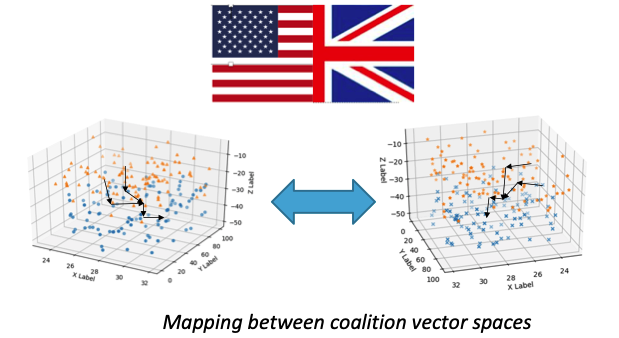Semantic Vector Mapping for Coalition Operations
Military / Coalition Issue
We have shown that in order to unambiguous communicate information or to describe sensors and services different coalition partners can use symbolic semantic vector representations. In coalitions different partners may use completely different language (including foreign language) to describe the same semantic concepts. Whilst this could be addressed by agreeing a coalition semantic vector space, different coalition partners may not be willing to share all the details of their semantic vector space or the training data necessary to construct a common coalition semantic vector space.
Is it possible to map semantic vectors between different vector spaces so that unambiguous communication or sensor and service descriptions can be exchanged and between coalition partners required to achieve specific mission goals?
Core idea and key achievements
The core idea is that semantic vector spaces generated independently using vector space embedding techniques (e.g., Word2Vec) from either different knowledge bases or document corpora will produce different semantic vectors but that the relationship between the vectors (e.g., cosine distance) will be maintained. Using completely different document corpora we have shown that this is indeed the case and that it is possible to use algebraic techniques and neural network techniques to learn the necessary mapping where the coalition partners only need to exchange a relatively small number of vectors that represent the same concepts.
Implications for Defence
This capability address key issues for interoperability in coalition operations where information needs to be exchanged or sensors and services need to be shared. This is specifically applicable in situations where the same capabilities exist in other parts of the coalition but have not been explicitly described because of sensitivity.

Readiness & alternative Defence uses
The approach has been demonstrated using different libraries of open-source data for word vector embeddings, but this could be extended to other types of military data including knowledge bases. Techniques for generating the vector space embeddings are described in another of our key outcomes.
Resources and references
- Graham Bent, Declan Millar, Douglas Summers-Stay, Shalisa Witherspoon and Jae-Wook Ahn. “Semantic Vector Space Mapping for Edge of Network Coalition Operation” DAIS AFM 2020
Organisations
IBM UK, Cardiff University, ARL, IBM US